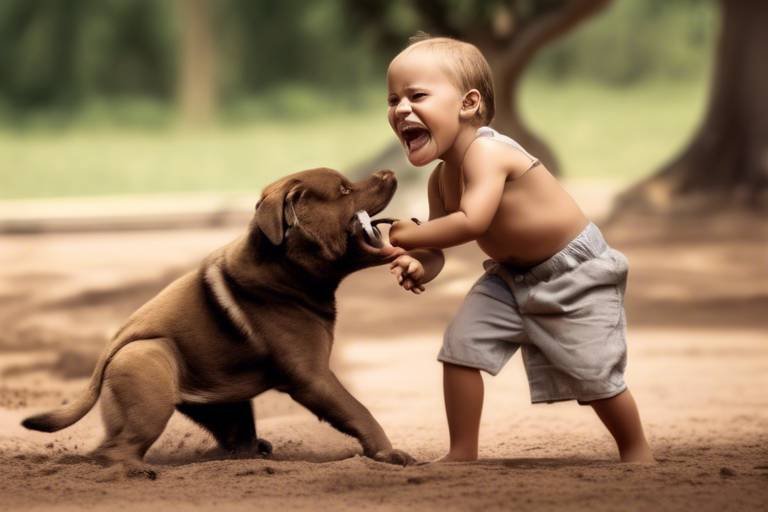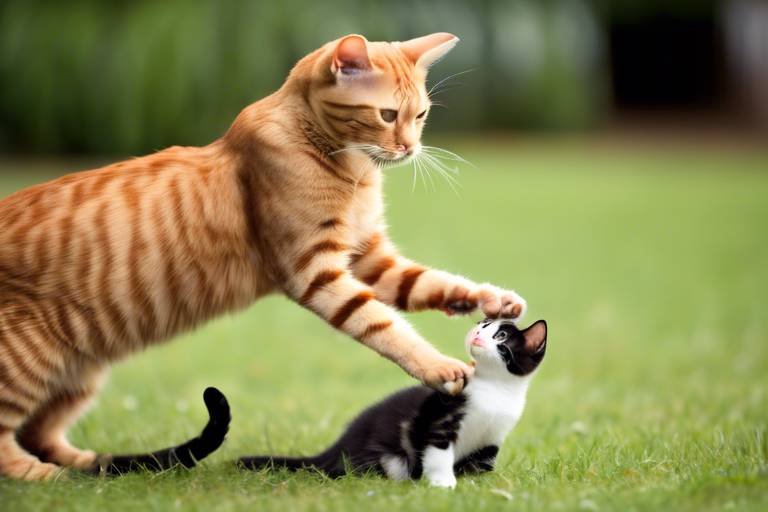Understanding the Role of Reinforcers in Training
Have you ever wondered why certain behaviors are repeated while others fade away? The answer often lies in the use of reinforcers. Reinforcement is a powerful tool in both animal training and human behavior modification. It’s not just about rewards; it’s about understanding how to effectively shape behavior through various types of stimuli. In this article, we will delve into the significance of reinforcers, their different types, and how they can be strategically applied to enhance learning processes.
At its core, reinforcement is a principle that hinges on the idea of reward and consequence. When a behavior is followed by a favorable outcome, the likelihood of that behavior being repeated increases. This is true whether you're training a dog to sit or motivating a student to complete their homework. The beauty of reinforcement is that it can be tailored to fit the needs of the individual being trained, making it a versatile approach.
Consider this: if you reward a child for cleaning their room, they are more likely to do it again in the future. This simple act of providing a reward reinforces the behavior. Similarly, in a workplace setting, employees who receive praise or bonuses for meeting targets are more inclined to maintain or even improve their performance. This dynamic is what makes understanding reinforcers so crucial for anyone involved in training or education.
As we explore the intricacies of reinforcement, we will uncover how timing, types, and misconceptions can impact the effectiveness of these strategies. So, buckle up as we embark on this journey to understand the role of reinforcers in training!
Reinforcement is more than just a buzzword; it's a fundamental principle in behavior training that can significantly alter the way we learn and interact. Let's break it down. Reinforcement can be defined as any stimulus that increases the likelihood of a behavior being repeated. It can manifest in various forms, affecting both animals and humans alike. Understanding this concept is essential for anyone looking to modify behavior effectively.
When it comes to reinforcement, there are several types to consider, each playing a unique role in training. The main categories include:
- Positive Reinforcement: This involves adding a rewarding stimulus after a desired behavior.
- Negative Reinforcement: This entails removing an unpleasant stimulus to strengthen a behavior.
- Primary Reinforcers: These fulfill basic needs, such as food and water.
- Secondary Reinforcers: These are learned and can include praise or money.
Each type has its own applications and can be utilized in various training scenarios, from classroom settings to animal obedience schools.
Positive reinforcement is perhaps the most widely recognized type. It involves providing a rewarding stimulus after a desired behavior, which encourages the behavior to be repeated. Think of it as a cheerleader for good behavior! Whether it’s giving a dog a treat for sitting on command or providing verbal praise to a student who answers a question correctly, positive reinforcement can significantly enhance motivation and learning.
Real-world examples of positive reinforcement abound. For instance, in the realm of animal training, when a dog successfully completes a trick and receives a treat, it associates the trick with the reward. In educational settings, teachers often use stickers or extra recess time as rewards for good behavior. These examples illustrate how rewards can bolster motivation and encourage the repetition of favorable actions.
Positive reinforcement is not limited to one field; it spans various domains, including:
- Education: Teachers use positive reinforcement to encourage student engagement and participation.
- Animal Training: Trainers use treats and praise to teach animals new commands or tricks.
- Behavioral Therapy: Therapists implement positive reinforcement strategies to help clients adopt healthier behaviors.
This versatility makes positive reinforcement a valuable strategy for anyone involved in teaching or training.
Negative reinforcement is often misunderstood. It does not mean punishment; rather, it involves the removal of an unpleasant stimulus to strengthen a behavior. For example, if a student studies hard to avoid the stress of failing a test, they are experiencing negative reinforcement. The unpleasant feeling of anxiety is removed when they achieve a passing grade, encouraging them to study again in the future.
Timing is everything in reinforcement strategies. Immediate reinforcement can significantly enhance learning outcomes and behavior retention. For instance, if a dog obeys a command, giving a treat right away helps the dog make the connection between the behavior and the reward. Delayed rewards can lead to confusion, making it harder for the individual to understand what behavior is being reinforced.
There are two primary methods of reinforcement: continuous and partial. Continuous reinforcement involves providing a reward after every desired behavior, while partial reinforcement offers rewards intermittently. Both methods have their advantages. Continuous reinforcement is effective for establishing new behaviors, while partial reinforcement can lead to more persistent behavior over time. Understanding the nuances between these methods can help trainers choose the most effective strategy for their specific goals.
Despite its effectiveness, many misconceptions surround reinforcement in training. Some people mistakenly believe that reinforcement is synonymous with bribery, while others think negative reinforcement is the same as punishment. In reality, reinforcement is a nuanced concept with a variety of applications. By addressing these myths, we can gain a clearer understanding of the true nature and effectiveness of various reinforcement strategies.
Q: What is the difference between positive and negative reinforcement?
A: Positive reinforcement adds a rewarding stimulus to encourage behavior, while negative reinforcement removes an unpleasant stimulus to strengthen behavior.
Q: Can reinforcement be harmful?
A: If not applied correctly, reinforcement can lead to dependency on rewards or reinforce undesirable behaviors. It's essential to use it thoughtfully.
Q: How important is timing in reinforcement?
A: Timing is crucial; immediate reinforcement is more effective than delayed rewards, as it helps the individual connect the behavior with the outcome.

The Concept of Reinforcement
Reinforcement is a fundamental principle in behavior training that serves as the backbone for modifying actions and enhancing learning processes. At its core, reinforcement is all about increasing the likelihood of a desired behavior by introducing a stimulus or removing an unpleasant one. Imagine teaching a dog to sit; when the dog complies, you reward it with a treat. This reward acts as a reinforcement, encouraging the dog to repeat the action in the future. But reinforcement isn’t just limited to training pets—it's a concept that applies to humans, too, in various contexts such as education, workplace motivation, and even personal development.
There are two primary types of reinforcement: positive and negative. Positive reinforcement adds a rewarding stimulus following a desired behavior, while negative reinforcement involves the removal of an unpleasant stimulus. Both methods aim to strengthen behavior, but they achieve this through different mechanisms. Understanding these nuances is essential for anyone involved in training, whether it be teachers, animal trainers, or even parents. For instance, when a student completes their homework on time and receives praise, they are more likely to repeat that behavior. On the flip side, if a child cleans their room to avoid a scolding, the unpleasant consequence is removed, reinforcing the cleaning behavior.
Reinforcement can also be categorized into primary and secondary reinforcers. Primary reinforcers are inherently satisfying, such as food or water, while secondary reinforcers, like money or praise, acquire their value through association with primary reinforcers. This distinction is crucial in understanding how different stimuli can be effectively employed in training scenarios. For example, in a classroom setting, a teacher might use stickers (a secondary reinforcer) to reward students for good behavior, which can motivate them to continue behaving well. In contrast, a coach might use water breaks (a primary reinforcer) to encourage athletes to push through tough drills.
In summary, reinforcement is a powerful tool in shaping behavior and learning. By understanding its types and applications, trainers and educators can create more effective strategies that lead to lasting changes in behavior. Whether you are working with animals or humans, recognizing the role of reinforcement can significantly enhance your training outcomes.

When we talk about reinforcement, it’s essential to understand that not all reinforcers are created equal. They come in various forms, each serving a unique purpose in the training process. The two primary categories of reinforcers are positive and negative, but within these categories, we also have primary and secondary reinforcers. Each type plays a crucial role in shaping behavior, whether in animals or humans.
Positive reinforcers are perhaps the most well-known and widely used. They involve presenting a rewarding stimulus after a desired behavior occurs. Think of it as giving a dog a treat after it sits on command. This method encourages the dog to repeat the behavior because it associates sitting with receiving something pleasurable. On the other hand, negative reinforcers are often misunderstood. They don't involve punishment but rather the removal of an unpleasant stimulus when a desired behavior is exhibited. For instance, if you take pain medication and the headache goes away, the removal of pain reinforces the behavior of taking the medication. It’s all about making behaviors more likely to occur in the future.
Now, let’s dive deeper into these categories:
| Type of Reinforcer | Description | Example |
|---|---|---|
| Positive Reinforcer | A stimulus that increases the likelihood of a behavior by providing a rewarding consequence. | Giving a child praise for completing their homework. |
| Negative Reinforcer | The removal of an unpleasant stimulus to increase the likelihood of a behavior. | Taking an umbrella to avoid getting wet. |
| Primary Reinforcer | A naturally reinforcing stimulus, such as food or water, that satisfies a biological need. | Feeding a hungry animal. |
| Secondary Reinforcer | A stimulus that has become reinforcing through its association with a primary reinforcer. | Money, which can be exchanged for food or other needs. |
Understanding these types of reinforcers is fundamental to effective training. For instance, in animal training, a trainer might use positive reinforcement to teach a trick, while in educational settings, teachers might employ both positive and negative reinforcers to encourage student engagement. Imagine a classroom where students receive gold stars (a secondary reinforcer) for good behavior, and the noisy classroom (the negative stimulus) quiets down when students focus on their work. It’s a dynamic interplay that can lead to significant improvements in behavior and learning outcomes.
Moreover, the application of these reinforcers isn’t limited to training animals or children. In workplaces, managers can utilize positive reinforcers, like bonuses or recognition, to motivate employees. Understanding the key differences and applications of these reinforcers can transform how we approach learning and behavior modification in various settings.
Positive reinforcement is a powerful tool in the realm of behavior training, and it works like magic! Imagine you’re teaching a puppy to sit. Each time it plops down on command, you shower it with praise or offer a tasty treat. This delightful experience makes the puppy want to repeat the action again and again. In essence, positive reinforcement is all about providing a rewarding stimulus after a desired behavior, which encourages the subject to repeat that behavior in the future. It’s like planting seeds of good habits that blossom into consistent actions.
The effectiveness of positive reinforcement lies in its ability to create a positive association with the desired behavior. When individuals—whether they are pets or people—experience something enjoyable following a specific action, they are more likely to engage in that action again. This principle applies not only to animals but also to human learning. Think about it: when students receive praise for a job well done, they are more inclined to put in the effort next time. It’s a win-win situation where both the trainer and the learner benefit.
Let’s break it down further. Positive reinforcement can take many forms, including:
- Verbal Praise: Compliments and encouragement can boost confidence and motivation.
- Tangible Rewards: Treats, toys, or gifts can serve as incentives.
- Privileges: Allowing someone to engage in a preferred activity can reinforce good behavior.
In various fields, positive reinforcement is utilized in innovative ways. In education, teachers often use praise to encourage student participation and effort. In animal training, trainers might use treats or toys to reinforce commands. Even in behavioral therapy, positive reinforcement can help individuals develop healthier habits. This versatility showcases the power of positive reinforcement in shaping behavior across different contexts.
However, it’s essential to use positive reinforcement wisely. Over-rewarding can lead to dependency, where the learner only performs the desired behavior in anticipation of a reward. Therefore, it’s crucial to balance rewards and gradually fade them out as the behavior becomes more habitual. This approach not only solidifies the behavior but also fosters intrinsic motivation, where the individual finds satisfaction in the action itself, rather than relying solely on external rewards.
In summary, positive reinforcement is a dynamic and effective strategy for encouraging desirable behaviors. By creating a positive learning environment and offering meaningful rewards, trainers can significantly enhance motivation and learning outcomes. The next time you’re working with a learner, remember the power of a simple "Well done!" or a tasty treat—these little gestures can go a long way in reinforcing positive behavior!
Positive reinforcement is a powerful tool in both training and behavior modification. It’s like giving a high-five to your brain every time you do something right! For instance, think about how you feel when someone praises your work. That warm glow of appreciation is a perfect example of positive reinforcement. It not only makes you feel good but also encourages you to keep doing what you did to earn that praise. This concept can be applied across various contexts, from the classroom to the animal training arena.
In the classroom, teachers often use positive reinforcement to encourage students to participate and excel. For example, when a student answers a question correctly, the teacher might offer verbal praise or even a small reward, such as a sticker. This simple act not only boosts the student’s confidence but also reinforces the behavior of participating in class discussions. Over time, students begin to associate participation with positive outcomes, making them more likely to engage in the future.
Similarly, in the realm of animal training, positive reinforcement is a go-to strategy. Imagine a dog learning to sit. When the dog sits on command, the trainer immediately rewards it with a treat or a toy. This reward creates a positive association with the command, leading the dog to repeat the action in hopes of receiving more treats. It’s a win-win situation— the dog learns, and the trainer enjoys the process of teaching.
Here are a few more real-world examples of positive reinforcement:
- Workplace Recognition: Employees who receive recognition for their hard work are more likely to remain motivated and productive. Whether it’s through bonuses, promotions, or simple acknowledgment during meetings, positive reinforcement fosters a productive work environment.
- Parenting Techniques: Parents often use positive reinforcement to encourage good behavior in children. For instance, when a child shares their toys, a parent might respond with praise or a special treat, reinforcing the idea that sharing is a desirable behavior.
- Sports Coaching: Coaches frequently employ positive reinforcement by praising athletes for good performance. This not only boosts morale but also encourages athletes to maintain or improve their performance during practices and competitions.
In summary, positive reinforcement is a versatile and effective strategy that can be applied in various settings. By providing rewards or recognition after desired behaviors, we can encourage individuals—whether they are students, employees, pets, or children—to continue those behaviors. The beauty of positive reinforcement lies in its simplicity and effectiveness; it’s all about creating a positive feedback loop that motivates and inspires. So, the next time you find yourself in a teaching or training scenario, remember the power of a simple "good job!"
Q: What is positive reinforcement?
A: Positive reinforcement involves providing a rewarding stimulus after a desired behavior, encouraging the repetition of that behavior.
Q: Can positive reinforcement be used in all training scenarios?
A: Yes, positive reinforcement is versatile and can be applied in various contexts, including education, animal training, and workplace settings.
Q: How does positive reinforcement differ from negative reinforcement?
A: Positive reinforcement adds a rewarding stimulus to strengthen behavior, while negative reinforcement removes an unpleasant stimulus to encourage behavior.
When it comes to the world of training, whether for animals, children, or even adults, the application of positive reinforcement is a game-changer. Imagine teaching a dog to sit. Each time it obeys, you offer a treat. This immediate reward not only makes the dog happy but also reinforces the behavior, making it more likely to repeat it in the future. This principle applies across various fields, demonstrating just how versatile positive reinforcement can be.
In the realm of education, teachers frequently utilize positive reinforcement to encourage student participation and engagement. For instance, a teacher might reward students with stickers or praise for completing assignments on time. This not only boosts the students’ self-esteem but also promotes a positive learning environment. The connection between effort and reward becomes clear, motivating students to strive for success. In fact, studies show that classrooms that implement reinforcement strategies often see improved academic performance and classroom behavior.
Similarly, in animal training, trainers rely heavily on positive reinforcement techniques. For example, a trainer might use clicker training, where a click sound signifies a correct behavior followed by a treat. This method is particularly effective in training pets, as it helps them associate good behavior with positive outcomes. The beauty of this approach is that it builds trust between the animal and the trainer, creating a bond that enhances learning.
In the field of behavioral therapy, positive reinforcement plays a crucial role in helping individuals modify their behaviors. Therapists often use reward systems to encourage clients to engage in positive actions or to break negative habits. For instance, a therapist might set up a rewards chart for a child struggling with anxiety, where each time the child faces a fear, they earn points towards a larger reward. This not only fosters a sense of achievement but also encourages the child to confront their fears, reinforcing their progress.
Moreover, positive reinforcement isn’t just limited to formal training settings. In everyday life, we often see its effects in the workplace. Employers may recognize and reward employees for outstanding performance, leading to increased motivation and productivity. When workers feel appreciated, they are more likely to go above and beyond, creating a positive cycle of reinforcement that benefits both the individual and the organization.
In conclusion, the applications of positive reinforcement are vast and varied. From classrooms to training sessions and even in everyday interactions, the principles of reinforcement can significantly enhance learning and behavior. By understanding and implementing these strategies effectively, we can create environments that foster growth, motivation, and success.
- What is positive reinforcement? Positive reinforcement is the practice of adding a rewarding stimulus after a desired behavior to encourage its repetition.
- How does positive reinforcement differ from negative reinforcement? While positive reinforcement adds a pleasant stimulus, negative reinforcement involves removing an unpleasant stimulus to strengthen a behavior.
- Can positive reinforcement be used in adult training? Absolutely! Positive reinforcement can be effective in various adult training scenarios, including workplace training and personal development.
- What are some common rewards used in positive reinforcement? Rewards can vary widely, from verbal praise and stickers to treats and bonuses, depending on the context and the individuals involved.
Negative reinforcement is often surrounded by confusion, leading many to mistakenly equate it with punishment. However, it's essential to understand that negative reinforcement is about strengthening a behavior by removing an unpleasant stimulus. Imagine you're driving a car, and the seatbelt alarm goes off because you haven't buckled up. When you fasten your seatbelt, the annoying sound stops. In this scenario, the removal of the irritating alarm serves as a negative reinforcer, encouraging you to buckle up in the future. This principle is not just applicable to humans; it also plays a significant role in animal training.
To delve deeper, let's break down the key components of negative reinforcement:
- Unpleasant Stimulus: This is the discomfort or annoyance that prompts a behavior change. In our car example, it was the seatbelt alarm.
- Behavior: The action taken to remove the unpleasant stimulus. Here, it was fastening the seatbelt.
- Removal of the Stimulus: Once the behavior is performed, the unpleasant stimulus is eliminated, reinforcing the behavior.
Negative reinforcement can be particularly effective in various training scenarios. For instance, in behavioral therapy, a therapist might help a client face their fears gradually. If a client feels anxious when discussing a particular topic, the therapist might allow them to take a break when the anxiety becomes overwhelming. This break acts as a negative reinforcer, encouraging the client to engage in the conversation more willingly next time, knowing they can take a break if needed.
It's crucial to note that negative reinforcement should be applied thoughtfully. If overused or misapplied, it can lead to unintended consequences, such as increased anxiety or avoidance behaviors. Therefore, trainers and educators must strike a balance, ensuring that the removal of the unpleasant stimulus genuinely supports learning and behavior modification.
In summary, negative reinforcement is a powerful tool in behavior modification. By understanding its mechanics and applying it correctly, trainers can foster an environment that encourages positive behaviors and helps individuals learn more effectively.
- Is negative reinforcement the same as punishment?
No, negative reinforcement strengthens a behavior by removing an unpleasant stimulus, while punishment aims to decrease a behavior. - Can negative reinforcement be harmful?
If misapplied, it can lead to anxiety and avoidance behaviors. It's essential to use it judiciously. - How does negative reinforcement work in animal training?
Trainers often use negative reinforcement by removing discomfort or stress when the animal performs the desired behavior.

When it comes to training, whether it's for animals or humans, timing can be the secret sauce that makes a good reinforcement strategy truly great. Imagine you're teaching a dog to sit. If you give the treat a second too late, the dog might not even connect the action with the reward. This delay can lead to confusion and hinder the learning process. In the world of behavior modification, immediate reinforcement is like striking while the iron is hot; it solidifies the connection between the desired behavior and its reward.
Research has shown that immediate reinforcement significantly enhances learning outcomes. For instance, in a classroom setting, a teacher who provides instant praise or feedback to students after they answer questions correctly can boost their confidence and encourage them to participate more. This immediate response creates a positive feedback loop that not only reinforces the behavior but also makes learning more enjoyable. Think of it as a dance—if the rhythm is off, the steps can become awkward and disjointed.
To illustrate the importance of timing, consider the difference between continuous reinforcement and partial reinforcement. Continuous reinforcement involves providing a reward every time a desired behavior is exhibited, while partial reinforcement offers rewards intermittently. Although both strategies can be effective, the timing of these rewards plays a crucial role in how well the behavior is learned and maintained over time. For example, if a child is rewarded for completing their homework every single time, they might expect a reward each time they do it. However, if rewards are given sporadically, the child learns to do the homework for the sake of the task itself, rather than just for the reward.
| Reinforcement Type | Timing | Effect on Learning |
|---|---|---|
| Continuous Reinforcement | Immediate | Quick learning, but can lead to dependency on rewards |
| Partial Reinforcement | Intermittent | Long-lasting behavior change, less dependency on rewards |
Furthermore, the concept of delay discounting comes into play. This psychological phenomenon describes how the perceived value of a reward decreases as the delay to receive it increases. If a child knows they will receive a reward for good behavior, but it’s promised at the end of the week, the motivation may wane as the days pass. In contrast, if the reward is given immediately, the child is more likely to associate their good behavior with the positive outcome.
Ultimately, the effectiveness of any reinforcement strategy hinges on the timing of the reward. Whether you’re training a puppy or coaching a sports team, understanding the nuances of timing can make all the difference. It’s about creating a clear and immediate connection between the action and the consequence, which not only enhances learning but also builds a stronger bond between the trainer and the learner.
- Why is immediate reinforcement important?
Immediate reinforcement helps the learner connect the behavior with the reward, leading to faster and more effective learning. - What is the difference between continuous and partial reinforcement?
Continuous reinforcement rewards every desired behavior, while partial reinforcement rewards intermittently, which can lead to more sustainable behavior change. - How can I improve my timing in reinforcement?
Practice observing the behavior closely and respond as soon as the desired action occurs to ensure the connection is clear.
When it comes to training, understanding the difference between continuous and partial reinforcement is crucial. Think of it like watering a plant: if you water it every day, it thrives, but if you only water it occasionally, it learns to survive with less. Similarly, in behavior training, continuous reinforcement involves providing a reward every single time the desired behavior occurs. This method is particularly effective in the early stages of learning, as it helps to establish a strong connection between the behavior and the reward. For instance, if you’re teaching a dog to sit, giving a treat every time it sits reinforces that behavior quickly and effectively.
On the other hand, partial reinforcement is like a game of chance. You don’t always win, but when you do, it feels fantastic! In this approach, rewards are given only some of the time after the desired behavior is displayed. This strategy can lead to more resilient learning, as the individual learns to persist in their behavior even when the reward isn’t guaranteed. For example, if a student studies hard for a test and only occasionally receives praise from the teacher, they may become more motivated to study, hoping for that occasional recognition. This unpredictability can often lead to stronger, more lasting behavior changes.
To better understand these two types of reinforcement, let’s take a look at the following table:
| Aspect | Continuous Reinforcement | Partial Reinforcement |
|---|---|---|
| Definition | Reward after every desired behavior | Reward after some desired behaviors |
| Learning Speed | Fast learning | Slower learning initially |
| Behavior Persistence | Weaker persistence | Stronger persistence |
| Examples | Dog gets a treat every time it sits | Slot machines pay out occasionally |
In practice, trainers often start with continuous reinforcement to establish a behavior and then gradually shift to partial reinforcement to maintain that behavior over time. This transition can be likened to a coach who initially gives constant feedback to a player and later encourages them to perform on their own, relying on the skills they've developed. The key takeaway here is that while continuous reinforcement can lead to quick results, partial reinforcement can foster long-term behavior change.
In conclusion, both continuous and partial reinforcement have their places in training. The choice between the two depends on the goals of the trainer and the context of the learning situation. By understanding when to use each method, trainers can create effective strategies that not only modify behavior but also enhance the learning experience.
- What is the main difference between continuous and partial reinforcement?
Continuous reinforcement provides a reward every time a desired behavior occurs, while partial reinforcement rewards the behavior only occasionally. - Which method is better for long-term behavior change?
Partial reinforcement is generally better for long-term behavior change as it encourages persistence in the absence of rewards. - Can I switch from continuous to partial reinforcement?
Yes, many trainers start with continuous reinforcement to establish a behavior and then transition to partial reinforcement to maintain it.

When it comes to reinforcement, there are several misconceptions that can lead to confusion and misapplication in training. One of the biggest myths is that reinforcement is synonymous with bribery. In reality, while both involve offering something to encourage behavior, reinforcement is about promoting learning and positive behavior over time. It’s not just a one-time deal; it’s about building a foundation for future actions.
Another common misconception is that reinforcement only applies to animals. Many people believe that the principles of reinforcement are exclusive to dog training or animal behavior modification. However, humans are just as susceptible to reinforcement in their learning processes. Whether it’s a child receiving praise for completing their homework or an employee getting a bonus for meeting targets, the principles of reinforcement are universal.
Some might think that reinforcement is only effective when it is tangible, like treats or money. While these primary reinforcers can be effective, secondary reinforcers, such as praise or recognition, can be just as powerful. In fact, many argue that the emotional and psychological benefits of positive feedback can lead to more sustainable behavior change than material rewards.
Additionally, many believe that reinforcement is a one-size-fits-all approach. This couldn't be further from the truth! Different individuals respond to different types of reinforcement. For example, while one person may thrive on verbal praise, another might find it embarrassing. Understanding the individual needs of those being trained is crucial for effective reinforcement. This is why trainers often need to be flexible and adapt their strategies based on the responses they observe.
Timing also plays a critical role in how reinforcement is perceived. Some people think that it doesn’t matter when reinforcement occurs as long as it happens eventually. However, immediate reinforcement is often much more effective in cementing the desired behavior. The closer the reinforcement is to the action, the stronger the association becomes. This is particularly evident in scenarios where quick responses are required, such as in sports training or emergency response situations.
Lastly, a prevalent myth is that negative reinforcement is the same as punishment. This misunderstanding can lead to a lot of confusion. Negative reinforcement involves the removal of an unpleasant stimulus to increase a desired behavior, whereas punishment aims to decrease an undesired behavior. For instance, consider a student who studies hard to avoid the stress of failing an exam. Here, the removal of the stress (an unpleasant stimulus) reinforces the studying behavior. Understanding this distinction is vital for anyone involved in training, as it can greatly affect how behaviors are shaped.
In summary, addressing these misconceptions is essential for anyone looking to implement effective reinforcement strategies. By understanding the true nature of reinforcement, trainers can create a more positive and productive learning environment.
- What is the difference between positive and negative reinforcement? Positive reinforcement adds a rewarding stimulus after a desired behavior, while negative reinforcement removes an unpleasant stimulus to strengthen behavior.
- Can reinforcement be harmful? Yes, if not applied correctly, reinforcement can lead to dependency on rewards or unintended behaviors. It’s crucial to balance reinforcement with intrinsic motivation.
- How can I determine the best type of reinforcement for someone? Observe their responses to different stimuli, and consider their preferences. Tailoring reinforcement to individual needs often yields the best results.
Frequently Asked Questions
- What is reinforcement in training?
Reinforcement is a technique used in behavior training to encourage the repetition of desired behaviors. It involves providing a stimulus that increases the likelihood of a behavior being repeated. Think of it as a way to reward good behavior, making it more appealing to continue that behavior in the future.
- What are the different types of reinforcers?
There are several types of reinforcers, including positive reinforcers, negative reinforcers, primary reinforcers, and secondary reinforcers. Positive reinforcers add a pleasant stimulus, while negative reinforcers remove an unpleasant one. Primary reinforcers fulfill basic needs, like food, while secondary reinforcers are learned, like money or praise.
- How does positive reinforcement work?
Positive reinforcement works by providing a reward after a desired behavior is exhibited. This reward can be anything from treats for a pet to praise for a child. The key is that the reward makes the behavior more likely to occur again, creating a positive feedback loop.
- Can you give examples of positive reinforcement?
Absolutely! In animal training, giving a dog a treat for sitting on command is a classic example. In schools, teachers might use stickers or extra playtime as rewards for good behavior. Even in the workplace, recognition and bonuses can serve as positive reinforcement for achieving targets.
- What is negative reinforcement?
Negative reinforcement can be a bit tricky to understand. It doesn't mean punishment; instead, it involves removing an unpleasant stimulus to strengthen a behavior. For example, if a loud noise stops when a student raises their hand, they are more likely to raise their hand again in the future to avoid the noise.
- Why is timing important in reinforcement?
Timing is crucial because immediate reinforcement tends to yield better learning outcomes. When the reinforcement follows the behavior closely, it creates a clear connection in the learner's mind, making it easier to associate the reward with the action.
- What is the difference between continuous and partial reinforcement?
Continuous reinforcement means providing a reward after every desired behavior, while partial reinforcement involves giving rewards only sometimes. Continuous reinforcement is great for initial learning, but partial reinforcement can lead to more resilient behaviors that last longer over time.
- Are there any common misconceptions about reinforcement?
Yes, one common misconception is that reinforcement is the same as punishment. While punishment aims to decrease a behavior, reinforcement aims to increase it. Another myth is that negative reinforcement is bad; in reality, it can be a powerful tool for encouraging positive behaviors when used correctly.



















